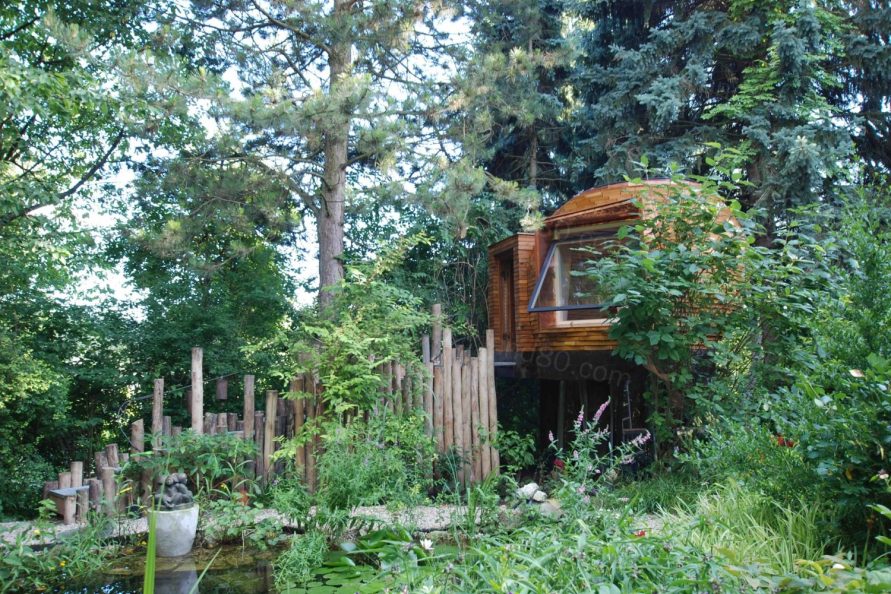项目位于下奥地利地区,设计灵感源于一个传统日本茶室。项目被设计成一个具有现代建筑风格的多功能茶室。它既可作为品茗和享受宁静的场所,还可为接受回归疗法的客户提供留宿的空间。
The concept of a traditional Japanese teahouse inspired the project located in Lower Austria. The building was designed as a contemporary interpretation of a teahouse that allows for a more diverse use. It serves as a place for drinking tea and observing silence and as a space for regression therapy for clients with the possibility for overnight stays.



从附有诊疗室的私人住宅中所分离,茶室坐落在庭院中的一片苍翠之间。由树干组成的四根支柱犹如从地面生出的有机结构,植被自由生长遍布其底部及周围。尽管建筑物的绝大部分生长于基座之上,但是体量硕大的深色基座使茶室看起来稳定而坚固。通往建筑物的坡道显得十分自然妥帖。这种由树干制成的坡道形制,源自下奥地利地区酒农的传统做法。茶室与坡道之间由一小块空隙相隔。
Separated from the private house with an attached therapy room the teahouse is located in the property’s garden, among trees and bushes. Four pillars, made out of tree trunks, elevate the organic structure from the ground and allow the vegetation to grow both under and around the building. The massive black base adds the feeling of stability and durability to the teahouse, while the rest of the building rises organically from the base. A ramp serves to access the building comfortably. It is made out of tree trunks, as traditionally used by wine farmers in Lower Austria, and separated from the teahouse by a small gap.




为了在赋予建筑有机形式的同时仍采用一种低技术的建造方式,我们使用了小体量的木制砌块。当地的一位木桶制造商提供了大量可以在现场回收利用的橡木砌块。基于预制模板的形状,木制砌块彼此叠加多达40余层。一个插入茶室有机形状的梯形框架,勾勒出了窗户的范围。通过橡木和铜的物质属性, 茶室与生机勃勃遍布植被的花园融为了一体。
To create the building’s organic form while still using a low-tech approach to the construction, we used small timber offcuts. A local barrel-maker provided the oak wood offcuts that were recycled on site. The timber pieces were stacked above each other in more than 40 layers, following the form of pre-built templates. A trapezoid shape, inserted into the organic form of the teahouse, frames the big window. Through the materiality of oak timber and copper, the teahouse fits into the surrounding vegetation and becomes part of the grown garden.



低矮狭窄的茶室入口使室内空间看起来宽敞许多,身处建筑内部感觉如同待在洞穴或子宫般安全。透过天花板椭圆天窗的涂色玻璃,太阳光在建筑物内部熠熠生辉。为此女业主的一幅画还被印在了玻璃上。
The low and narrow entrance of the teahouse opens up to the seemingly spacious interior. The inside features a protecting character like a cave or a uterus. An oval opening in the ceiling allows natural lighting to gleam into the building through painted glazing. For this purpose, a painting by the owner herself was printed on glass.


其中较小的窗户使人得以近距离观察树干上的纹理。巨大方窗的窗框兼作供人休息的坐具。窗框将人的视线直接引向游泳池的同时也把目光聚焦到了建筑的诊疗室。
The small window offers a close look onto the bark of a nearby tree trunk. The frame around the big square window serves as a piece of furniture inviting to sit down. It directs the views towards the swimming pond as well as to the therapy room in the existing building.


茶室的主要建筑材料是取自当地的橡木砌块。我们回收这些由当地酒桶制造商剩余的小木制砌块,来为茶室的结构提供材料。建筑内部的固定装置及家具亦由橡木所制成。
The main material for the Teahouse is locally chopped oak timber. Due to the chosen construction method, we were able to recycle small timber offcuts of a local wine-barrel-maker for the main structure of the teahouse. The furniture and fixtures are made out of oak timber as well.
设计单位 a-lp architektur
项目地址 奥地利
项目面积 10.0 m2
项目时间 2016
摄影师 Christine Leuthner
|